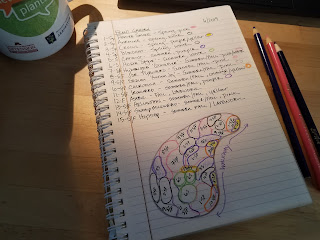Smart Garden 2020: It's time to ... keep calm and garden!
Even without social distancing, Minnesota gardeners get a little stir crazy this time of year. We are teased by 60 degree days, warm sun and snow melt. We're itching to rake our grass and clean up garden beds. Spring ahead daylight savings time means it's still light out after the workday (translation: more time in the garden).
But Minnesota gardeners also know that it's safer to hold off on planting and raking until temperatures steady out and lawns dry out. Planting into cold wet soil can result in poor seed germination, and raking spongy lawns can shred grass plants. And then there is always the chance of a late frost that can nip newly emerged plants or tender annuals set out too early.
During this "watch-and-wait" time of the year, we can still do a few things that get our hands dirty and also some solid planning for the coming year.
 |
| Photos: Julie Weisenhorn, UMN Extension |
Create a garden plan
A garden plan can be as simple or as elaborate as you wish. This time of the season is a good time to measure your garden and sketch it on graph paper. Then layout your planting for the coming season. Use colored stick notes labeled with plant name and cut to the plant's mature size so you can move them around. Be sure to leave space around plants for good air circulation, light and access.
Some math formulas that are helpful when measuring an area:
Area of a rectangle = length x width
Area of a triangle = base x height / 2
Area of a circle = 3.14 x radius 2
Think about succession planting where you plant a new crop as another crop finishes.
Start seeds indoors for your garden outdoors.
- Mid-March is a good time to start seeds indoors that require about 8 weeks of growing before they can be planted outside.
- Minnesota gardens are typically planted between May 10-31 depending on where you are located in the state. By then, we are usually past our average last frost date and risk of any cold damage.
- Seeds can still be ordered online. Refer to the seed packet for timing.
- Refer to Starting seeds and planting
Select your favorite plants and plant for pollinators.
Choose plants that you really love eating, growing, smelling, tasting. Remember to plant for our all-important pollinators, birds, butterflies, and other wildlife you want to attract.
Re-think your lawn space
Interested in a bee lawn? Minnesotans of all kinds - homeowners, community gardeners, municipalities, public spaces, golf courses, schools, etc. - are establishing more and more flower-full plantings to help bees and other pollinators. Consider planting a bee lawn this year in your yard to provide healthy habitat and food for bees. Bee lawns are comprised of cool season lawn grasses like fine fescues or Kentucky bluegrass and low-growing, bee-friendly flowering plants.
Get to know your soil
Our soils are thawing, so consider collecting and submitting a soil sample to the UMN Soil Testing Lab. Soil is the foundation of every landscape and the more you know about your soil, the better you are at keeping it healthy and your plants healthy. A soil test should be done about every 3-5 years and any time you plan to make a big change in how you use part of your landscape (i.e changing lawn to garden).
Still time to prune
You can still get outside and prune fruit trees, crabapples, maples, birch, oaks until April 1st.
How to prune apple trees - 3-part video series
Author: Julie Weisenhorn, Extension Educator, Horticulture

